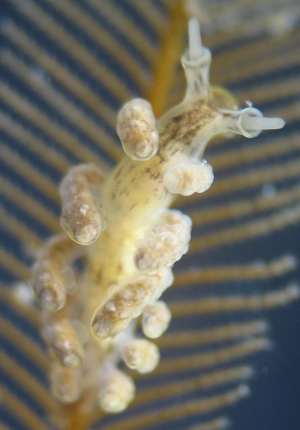
Doto columbiana
O'Donoghue, 1921
Order: NUDIBRANCHIA
Suborder: DENDRONOTINA
Family: Dotidae
DISTRIBUTION
British Columbia, Canada to Santa Barbara, California
PHOTO
Upper right photo: Cayucos, California, USA. Intertidal. Length: 7.8 mm. 28 January 2006. Rocky shore. Photographer: Jeff Goddard
Along with Doto kya, this one of two species of Doto known from the cold temperate waters of the northeastern Pacific Ocean with dark pigmentation on the body, head, rhinophore sheaths and cerata. The brown to black pigmentation is more diffuse than in Doto kya and occurs on the sides of the body down to the edge of the bottom of the foot. The pigmentation often forms complete or broken, but not very dark rings around the bases of the cerata tubercles, especially the more distal ones [Lower left]. The amount of pigmentation can vary significantly between individuals, and some individuals, especially their cerata, are only lightly colored [Lower right]. The ceratal tubercles are short compared to the other NE pacific species of Doto, and the cerata of specimens may appear relatively smooth (this is especially the case for preserved specimens not relaxed prior to fixation). Adults are usually less than 10 mm in length and possess 5 to 7 pairs of cerata. The ground color of the body is translucent cream to pale yellow, and the rhinophores and their sheaths do not possess the opaque white, spherical inclusions found in those of Doto kya.
Doto columbiana feeds and lays its egg masses on Aglaophenia spp., usually on the polyp-free sides of the branches, and can be locally abundant on the hydroid.
- O'Donoghue, C. H. (1921) Nudibranchiate Mollusca from the Vancouver Island region. Transactions Royal Canadian Institute, 13: 147-209.
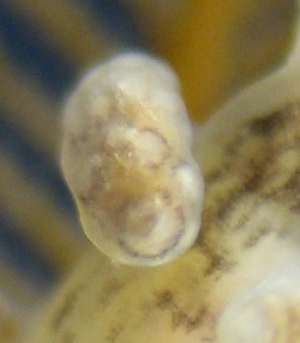
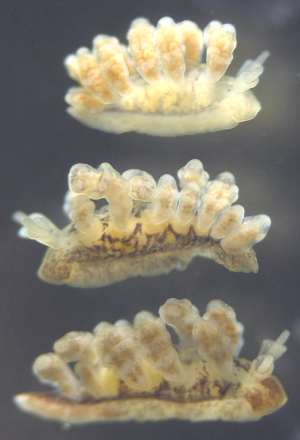
Goddard, J.H.R., 2006 (February 7) Doto columbiana O'Donoghue, 1921. [In] Sea Slug Forum. Australian Museum, Sydney. Available from http://www.seaslugforum.net/find/dotocolu
Related messages
Doto columbiana from British Columbia
September 11, 2007
From: Clinton Bauder

Hi Bill,
I think the dark markings extending onto the foot make this one Doto columbiana.
Also I think you mentioned in a previous message that caprellid shrimps were reputed to displace nudibranchs off of hydroids. As you can see in this and several of my Eubranchus photos in British Columbia at least the arthropods and molluscs seem to coexist.
Locality: Browning Pass, 15 meters, British Columbia, Canada, Pacific, 27 August 2007, Rock Wall. Length: 4 mm. Photographer: Clinton Bauder.
Clinton Bauder
gecko1@apple.com
Bauder, C., 2007 (Sep 11) Doto columbiana from British Columbia. [Message in] Sea Slug Forum. Australian Museum, Sydney. Available from http://www.seaslugforum.net/find/20649
Hi Clinton,
Nice catch. I have personally never seen this species but it certainly follows O'Donoghue's original description. The black markings on the body show well, but the rings around the tubercles on the cerata are very, very vague.
Thanks for sharing,
Dave Behrens
Fact sheet and additional photos of Doto columbiana
February 8, 2006
From: Jeff Goddard
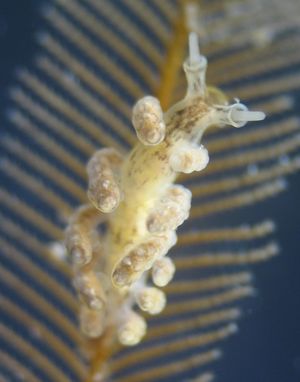
Hi Bill,
I've done a bit more collecting and photographing to prepare this Fact Sheet for Doto columbiana.
Locality: Cayucos, California, USA. Intertidal. Length: 7.8 mm. 28 January 2006. Rocky shore. Photographer: Jeff Goddard
Best wishes,
Jeff
goddard@lifesci.ucsb.edu
Goddard, J.H.R., 2006 (Feb 8) Fact sheet and additional photos of Doto columbiana. [Message in] Sea Slug Forum. Australian Museum, Sydney. Available from http://www.seaslugforum.net/find/15760Dear Jeff,
Thanks for this. Fact Sheets are always welcome, and certainly give me a little extra time to address the backlog.
Best wishes,
Bill Rudman
Re: Doto from Monterey, California
January 30, 2006
From: Jeff Goddard
Concerning message #15117:
Hi Bill and Dave,
Yes, Clinton's Doto [message #15117] are what I referred to as Doto form B in my 1996 paper and now consider to be Doto columbiana. The up to 5 or 6 pairs of cerata, with low tubercles, and variable amounts of dark pigment on the body and between the cerata tubercles are characteristic. This species (along with Dendronotus subramosus) is also typically found on Aglaophenia, which is the hydroid in Clinton's photos.
Best wishes,
Jeff
goddard@lifesci.ucsb.edu
Goddard, J.H.R., 2006 (Jan 30) Re: Doto from Monterey, California. [Message in] Sea Slug Forum. Australian Museum, Sydney. Available from http://www.seaslugforum.net/find/15687Thanks Jeff,
Things do get complicated ... I'll move it from Doto amyra.
Bill Rudman
Variation in Doto columbiana from California
January 30, 2006
From: Jeff Goddard
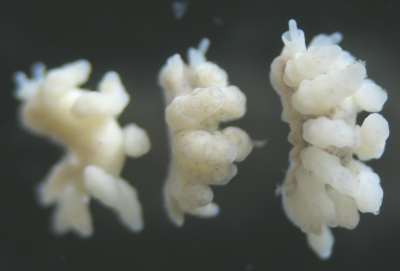
Hi Bill,
Here is an image of the preserved specimens I referred to in my previous message [#15676] about Doto columbiana.
"I have included a photo of three specimens I collected in November 2004 from Aglaophenia at Purisima Point, Santa Barbara County, California, showing similar variation in preserved specimens. The cerata tubercles on the middle specimen, which is 3.3 mm long, are ringed by dark pigment, while the cerata on the specimen on the left are completely light colored, and those on the larger specimen contain only faint, broken rings of pigment"
Locality: Purisima Point, California, USA. Pacific coast. Intertidal. Length: 3.3 mm (middle specimen) collected 13 November 2004. Rocky shore
Photographer: Jeff Goddard [Lower left: middle specimen; Lower right: right specimen]
Best,
Jeff
goddard@lifesci.ucsb.edu
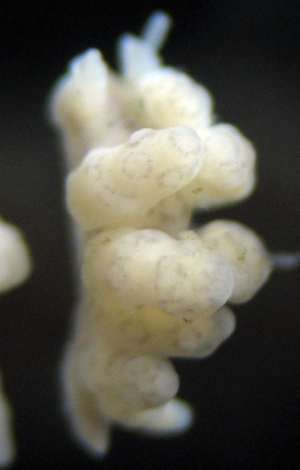
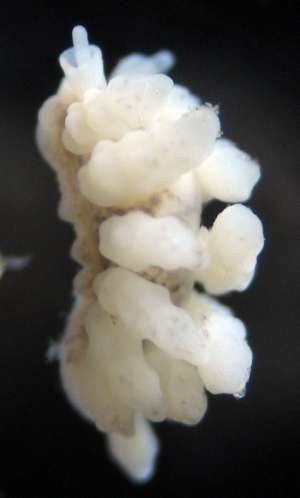
Doto columbiana from California and Oregon
January 30, 2006
From: Jeff Goddard
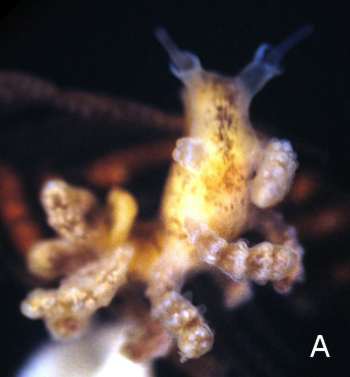
Hi Bill,
Here are some photos of Doto columbiana. In my 1996 paper on development in Doto amyra, I referred to these specimens as Doto form B and stated that they might be a light form of Doto columbiana. After reexamining the evidence, including specimens collected more recently, I believe these are Doto columbiana and also realize that I erred in assuming that this species - with dark pigment on the body - might be identified as Doto amyra, which typically lacks any dark pigment. This species is correctly identified in McDonald and Nybakken (1980) and McDonald (1983), but the specimen pictured as Doto columbiana in Behrens (1991) is actually Doto kya, the other species of Doto with dark pigment on the body known from north of Point Conception, California.
PHOTOS: A, Intertidal, South Jetty, Coos Bay, Oregon, July 1984; specimen of unknown length. Photo B, Rocky shore, mouth of Drake's Estero, Marin County, California, April 1984; specimens approx. 5 mm long. Photo C, Rocky shore, Montana de Oro, San Luis Obispo County, California, May 2005; largest specimen 4 mm, in MgCl2. Photographer: Jeff Goddard
Doto columbiana has 5 to 6 pairs of cerata, compared to 8 to 9 in Doto kya, and the tubercles on Doto columbiana are typically much flatter than in Doto kya, giving the cerata of some specimens an almost smooth appearance. Doto columbiana also lacks the opaque white grains found in the rhinophores and rhinophore sheaths of Doto kya. Doto columbiana is typically found on species of Aglaophenia, while Doto kya is usually on species of Plumularia. Both Doto columbiana and Doto kya produce small planktotrophic larvae.
I think that part of the confusion - at least my own - about the identity of Doto columbiana stemmed from the impression that the tubercles on the cerata of this species are always ringed by dark pigment, as originally described by O'Donoghue (1921) for 5 specimens dredged from the vicinity of Nanaimo, British Columbia. However, Marcus (1961) noted that this was the case for only five out of 25 preserved specimens from Dillon Beach, California. I have included a photo of three specimens I collected in November 2004 fromAglaophenia at Purisima Point, Santa Barbara County, California, showing similar variation in preserved specimens. The cerata tubercles on the middle specimen, which is 3.3 mm long, are ringed by dark pigment, while the cerata on the specimen on the left are completely light colored, and those on the larger specimen contain only faint, broken rings of pigment [see message #15677 ]. As seen in the attached photos of the living specimens, the cerata of Doto columbiana are often light colored and lack dark rings around the tubercles. In contrast, the more southerly
Doto lancei consistently has dark rings around the cerata tubercles. Further confusing the identification of Doto columbiana, Marcus (1961) stated that the number of pairs of cerata is 7, but the sketches of the whole animals in his Plate 7, one of which was based on a sketch of the living animal by the collector, clearly depict 5 to 6 pairs.
-
Behrens, D.W. 1991. Pacific Coast Nudibranchs. Sea Challengers, Monterey, California. 107 pp.
-
Goddard, J.H.R. 1996. Lecithotrophic development in Doto amyra (Nudibranchia: Dendronotacea), with a review of developmental mode in the genus. The Veliger 39(1):43-54.
-
Marcus, Er. 1961. Opisthobranch mollusks from California. The Veliger 3(Supplement 1):1-85.
-
McDonald, G.R. 1983. A review of the nudibranchs of the California coast. Malacologia 24(1-2):114-276.
-
McDonald, G.R. and Nybakken, J.W. 1980. Guide to the nudibranchs of California. American Malacologists, Inc., Melbourne, Florida. 72 pp.
-
O'Donoghue, C.H. 1921. Nudibranchiate Mollusca from the Vancouver Island region. Transactions of the Royal Canadian Institute 13:147-209.
Best wishes,
Jeff
goddard@lifesci.ucsb.edu
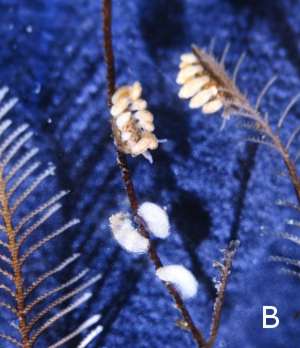
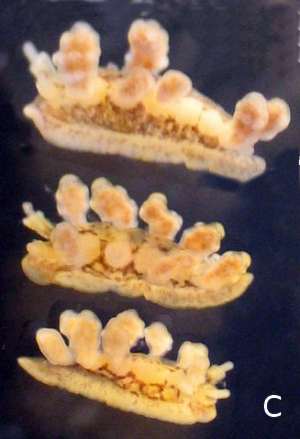
Thanks Jeff,
It's good to get these sorted out.
Best wishes,
Bill Rudman
Doto from Monterey, California
January 27, 2006
From: Clinton Bauder

Hi Bill,
I cam across these very small Doto on Monterey Breakwater. I suspect they are Doto amyra but I can see black markings on the body of some which makes me wonder if they are Doto columbiana. I saw lots of egg masses which I guess belong to the Doto but it is possible they belong to the Dendronotus which I also found there [message #15119 ]. The photos were taken by my friend Michael Jimenez
Locality: Monterey Breakwater, California, USA. Depth: 10 meters. Length: 20 mm. 22 October 2005. Hydroid on a rocky breakwater. Photographer: Michael Jimenez
Clinton Bauder
gecko1@apple.com
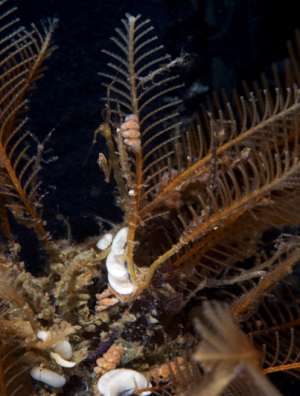
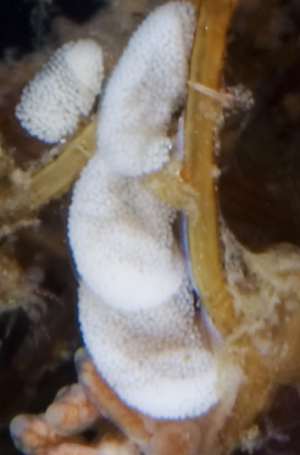
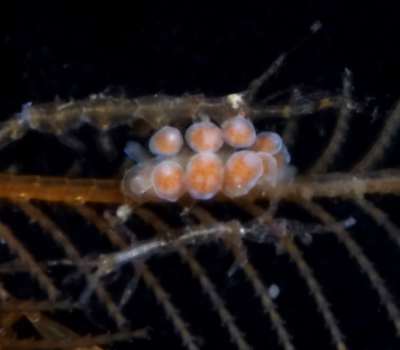
Note added 30 Jan 2006: See Jeff Goddard's message [#15687] saying that his Form B of Doto amyra is Doto columbiana.
Dear Clinton,
Wow... this seems to be the week for North Eastern Pacific Doto's. As mentioned in Marli's replies, and Goddard (1996), identification of Doto amyra can be a challenge. That said, Yes I agree, this is Doto amyra. I would say it is what Jeff referred to in his paper as Doto form B, but hopefully we will hear from him to confirm. In his paper Jeff indicates that form B, the cerata are smooth with only low tubercles, and there is dark pigment on the body.
Concerning the eggs, these are very typical Doto eggs. Note the long tangled string shaped Dendronotus egg mass at the top of page 118 in Behrens (2005) - Nudibranch Behavior.
-
Behrens, D.W. 2005. Nudibranch Behavior. New World Publications Inc. Jacksonville, Florida. 176 pp.
-
Goddard, J.H.R. 1996. Lecithotrophic development in Doto amyra (Nudibranchia: Dendronotacea), with a review of developmental modes in the genus. The Veliger, 39(1): 3-54.
Best wishes,
Dave Behrens
